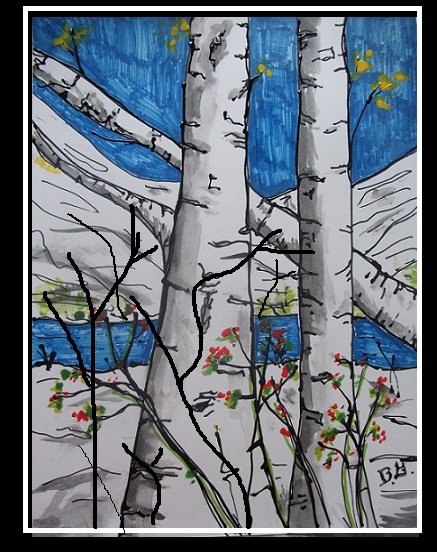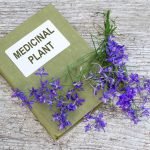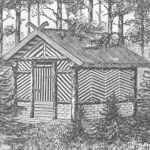The Medicine of The Birch Tree: Beyond Depurative
Robin DiPasquale, ND, RH (AHG)
A Reflection Of Birch Trees Through The Seasons
In fall, the flow of life is slowed, the birch leaves shrivel brown, lacking in the brilliant colors of her maple neighbors, and fall to the ground, often caught in the swirls of wind, carried far and wide. Bare branches silhouette against the sky, holding the sacred place of the birch lineage.
In winter, the birch tree stands among the frozen landscape, her white bark trunks reaching toward the heavens. In this time, she will spread seeds, brown flecks cloaking the white snow encircling the ground area around the tree. The wind will tug at her delicate branches, breaking off bits and pieces, leaving them strewn on the frozen landscape.
In spring, when the temperatures of the day are above freezing and the nights still wrapped in winter’s cold, the birch sap will begin to flow. The elixir of life is given freely by the birch. As the earth warms, the buds bulge, the catkins appear, and her leaves slowly open.
In summer the birch is fully leafed out in her serrated ruffles potato chip like green foliage, photosynthesizing nutrients, exhaling the precious oxygen that we depend on. Her branches sway in the light breeze, while graciously giving shade to the earth beneath her branches. The cycle is again completed.
(Robin DiPasquale)
History & Lineage of Birch
The birch tree (Betula spp) has deep roots in cultural history. Often called the “mother tree” because it was the first to grow as the Ice Age retreated, it represents fertility.1 Considered sacred by many cultures, birch has been thought of as “the way shower” because her bright, white bark illuminates the way in the night forest. Called the Cosmic World Tree, birch trees were used as “sky ladders” in Lapland and Siberia to travel, while in trance, to the sky world – the world of spirits and gods. Birch is one of the quintessentially feminine trees of ancient European cultures, as well as Native American traditions.2 Birch is called “the Lady of the Forest” in Russian folklore. Connected with Freya, the Lady of the Forest. in Norse and Germanic traditions, her energy connects to the feminine aspects of the universe and within oneself.3 Culpeper classified birch as being ruled by Venus.4
Alterative/Depurative Action of Birch
The medicinal actions of birch are diuretic, diaphoretic (in its ability to open sweat glands), inflammation-modulating, antiseptic, astringent, and anti-rheumatic. Dr Christopher says it is a cholagogue, and Matthew Wood writes about the use of the bitter resin of the boiled buds for gallbladder stagnation.5,6
More than any other action of the birch, the most unequivocal would be what the Europeans call depurative, the same action that is termed alterative in North America. Harvey Wickes Felter, one of the Eclectic physicians, wrote this defining description of alteratives:
…believed to act in a quiet and unexplainable manner, so as to modify disordered processes of nutrition. Most of them are eliminants of morbific material. How alteratives act is not always known, but their effects are apparent. Administered in small and continuous doses, alteratives improve the quality of the blood, increase appetite, promote digestion, and accelerate the process of elimination. They also improve the condition of the nerve centers, given an impetus to greater and healthier activity of circulation, and breathing organs. The results are those desired in the correction of faulty metabolism. The so called alteratives have been among the most useful of medicines in Eclectic therapy.7
Birch is among a long list of alterative/depurative herbs, some of the more commonly used ones being Arctium lappa, Baptisia tinctoria, Chionanthus virginicus, Echinacea spp, Fraxinus excelsior, Galium aparine, Hydrastis canadensis, Iris versicolor, Larrea tridentata, Mahonia spp, Phytolacca decandra, Anemone pulsatilla, Rumex crispus, Sanguinaria canadensis, Sassafras variifolium, Scrophularia nodosa, Smilax spp, Stillingia sylvatica, Trifolium pratense, and Urtica dioica. Birch, however, stands out strongly among this noble group of alteratives/depuratives for its ability to gently and thoroughly move the sap of the human body – the blood flow – as the sap in the birch tree flows during the spring, the time of the wood element, that of the liver.
Kidneys
The diuretic action of birch will accelerate the process of elimination through the kidneys. Culpeper says,
“The juice of the leaves, while they are young, or the distilled water of them, or the water that comes from the tree being bored with an auger, and distilled afterwards; any of these being drunk for some days together is available to the stone in the kidneys and bladder.”4
As Culpeper suggested, the sap can be tapped and ingested, and has been used by many cultures as a spring tonic. As with all sap, it has a tendency to ferment easily, so must be used in the early spring or preserved in some way. It can be stored short-term in the refrigerator, and adding cloves and a piece of cinnamon can help to prevent fermentation. It can also be frozen, or boiled down and canned, or it can be preserved with a percentage of alcohol and kept for later use. Because it is a spring tonic, however, using it during its sap flow in the spring will bring the depurative action that is so needed after a long winter of stagnancy, in a timely manner.
Used in hyperuricemia and gout, along with the gemmo remedy, Fraxinus excelsior (ash), the birch clears the blood while the ash alters the metabolism of uric acid formation through inhibition of xanthine oxidase. Consider birch in the early stages of renal disorders including albuminuria, nephritis, pyelitis, and polycystic kidney disease.8
Joints and Bones
In Germany, a tea of the birch leaves was used to cleanse the blood, muscles, and joints… a non-irritant diuretic that removes waste products without inflaming the kidneys (wood). Birch brings modulation of inflammation, alterative/depurative cleansing action, as well as bone regeneration through stimulation of osteoblastic activity (the gemmo remedy) – all significant applications for joint health. While different species can bring similar medicine, Betula verrucosa, the silver birch, is used more in pediatrics and for flexibility of articulations, while Betula pubescens, the white birch, works with the endocrine system and the strengthening of the skeletal system.9 Certainly, osteoarthritis and rheumatoid arthritis would benefit greatly from any birch as part of the treatment protocol. Related to bone health, consider using birch gemmo with issues that require remineralization, like growth delays or growing pain, rickets, osteoporosis, broken bones, and tooth decay. I often pair birch with other gemmos, tissue salts, or homeopathic remedies for optimal bone healing.
Skin
Medicinal uses of the birch for skin conditions have a long history in folk medicine. Under the doctrine of signatures, the skin is structured like layers of bark, indicating the use of birch for skin conditions. Native Americans prepared a mushy paste by boiling and pounding the inner bark, so it could be spread on inflammatory skin conditions, ulcers, cuts, and wounds, where it would diminish swelling and prevent infection.10 The harvesting of the bark is best done when the sap is flowing and when the moon is close to full, for this is when the water is running and the tree is more willing to let go of its bark. Tis Mal Crow says that the oils found in birch bark are very similar to those found in human skin, and when made into a water-based wash, soothes rough, itchy, and sensitive skin. Birch water can be used as a skin wash for rashes, dermatitis, sunburn, poison ivy, and insect bites and stings. Good for dandruff, cradle cap in children, or a psoriatic or seborrheic dry, flaky, itchy scalp. Birch tar is often used as an ingredient of ointments for psoriasis and eczema. For the thin skin of elderly, birch is given to prevent injuries and keep the skin toned.11
Bark is not the only part of the birch that is useful for skin. The alterative/depurative actions of the sap will benefit skin conditions by taking the burden of elimination off the skin, allowing liver and kidneys to take up the charge. The bud extract, the gemmo, will also act as a drainage remedy, a kidney drainage remedy with diuretic and inflammation-modulating actions, and a liver drainage remedy stimulating Kupffer cells, as well as modulating the immune system.
The gemmo of Betula verrucosa, the silver birch, is useful in pediatrics, being less strong in its actions than Betula pubescens/alba, white birch.9 White birch works the endocrine glands, stimulating the reproductive glands for males and females. Together with Quercus robur (oak) and Sequoiadendron gigantea (giant sequoia), it can be used for erectile dysfunction. Together with Vaccinium vitis-idaea (cowberry) and Rubus idaeus (raspberry), it is useful for female sexual arousal disorder. The male catkins are the yang part of birch and provide stimulating general endocrine action. For males, the catkin extract can be used in delayed puberty and during andropause, where it stimulates activity of the testes.12
Birch bark has been used historically in traditional herbal medicine to accelerate wound healing. A study done in 2010 provided insights into the molecular mechanism, showing that both the extract of the pentacyclic triterpenes and the isolated betulin facilitated 2 essential steps in the inflammatory phase of wound healing via transient upregulation of several inflammatory mediators and enhanced migration of keratinocytes.13 Another 2010 study showed the successful topical treatment with betulin emulsion of a severe necrotizing herpes zoster in an immunosuppressed patient who had not responded to a conventional topical treatment, demonstrating impressive skin tolerance and wound-healing properties of the betulin emulsion.14
The pentacyclic triterpenes in birch, betulinic acid and betulin, are compounds that appear to have significant anti-proliferative and anti-inflammatory actions.15 The anti-tumor activity of betulinic acid and betulin, through enhancing tumor necrosis factor (TNF) and inducing apoptosis, is shown in multiple studies. Betulinic acid shows promising results in early phases of clinical trials with basal cell carcinoma and squamous cell carcinoma.16 Betulin, which can be converted to betulinic acid, has been reported as a cytotoxic agent against several tumor cell lines, HeLa (cervix adenocarcinoma), MCF7 (breast adenocarcinoma) and A431 (skin epidermoid carcinoma), and as an apoptotic conductor.17
In this time, when skin is so easily damaged by the UV radiation from the sun, turning to one of the tree medicines, that of the feminine birch tree, can facilitate healing while also connecting us back to the rhythm of the cycles.
 Robin DiPasquale, ND, RH (AHG) earned her degree in naturopathic medicine from Bastyr University in 1995 where, following graduation she became a member of the didactic and clinical faculty. For the past 8 years, she has served at Bastyr as department chair of botanical medicine, teaching and administering to both the naturopathic program and the bachelor of science in herbal sciences program. Dr DiPasquale is a clinical associate professor in the department of biobehavioral nursing and health systems at the University of Washington in the CAM certificate program. She loves plants, is published nationally and internationally, and teaches throughout the U.S. and in Italy on plant medicine. She is an anusara-influenced yoga instructor, teaching the flow of yoga from the heart. She currently has a general naturopathic medical practice in Madison, WI, and is working with the University of Wisconsin Integrative Medicine Clinic as an ND consultant.
Robin DiPasquale, ND, RH (AHG) earned her degree in naturopathic medicine from Bastyr University in 1995 where, following graduation she became a member of the didactic and clinical faculty. For the past 8 years, she has served at Bastyr as department chair of botanical medicine, teaching and administering to both the naturopathic program and the bachelor of science in herbal sciences program. Dr DiPasquale is a clinical associate professor in the department of biobehavioral nursing and health systems at the University of Washington in the CAM certificate program. She loves plants, is published nationally and internationally, and teaches throughout the U.S. and in Italy on plant medicine. She is an anusara-influenced yoga instructor, teaching the flow of yoga from the heart. She currently has a general naturopathic medical practice in Madison, WI, and is working with the University of Wisconsin Integrative Medicine Clinic as an ND consultant.
References
- Birch and folk-lore: The Lady of the forest. http://stonelanegardens.com/wp-content/static/2011/09/Folk-lore-involving-Birch.pdf. Accessed February 15, 2014.
- The Magical Buffet: Where Spirituality, Politics, and Pop Culture Collide. http://themagicalbuffet.com. Accessed February 15, 2014.
- Struthers J. Using the Wisdom of Trees Oracle.London, England: Watkins Publishing; 2012.
- Culpeper N. Culpeper’s Complete Herbal. Reprint of 1814; London Edition in 1944. Glenwood, IL: Meyerbooks Publisher; 1987.
- Christopher J. School of Natural Healing. Springville, UT: Christopher Publications; 1976.
- Wood M. The Earthwise Herbal. Berkeley, CA: North Atlantic Books; 2008.
- Felter HW. The Eclectic Materia Medica, Pharmacology, and Therapeutics. First published in Cincinnati, OH; 1922:82-83.
- DiPasquale R. Gemmotherapy [introductory training manual]. Brooklyn NY: Gemmos LLC; 2013.
- Ledoux F, Gueniot G. The Embryo of Gemmotherapy. Amyris, Spain: Narayana Verlag; 2012.
- Plant Profile: Birch (Betula Ssp). Sacred Earth Web site. http://www.sacredearth.com/ethnobotany/plantprofiles/birch.php. Accessed February 15, 2014.
- Crow TM. Native Plants Native Healing: Traditional Muskogee Way, Summertown, TN: Native Voices Publishers; 2001.
- Andrianne P. Treatise on Gemmotherapy, The Therapeutic Use of Buds. Brussels, Belgium: Editions Amyris SPRL; 2012.
- Ebeling S, Naumann K, Pollok S, et al. From a traditional medicinal plant to a rational drug: understanding the clinically proven wouund healing efficacy of birch bark extract, PLoS One, 2014;9(1):e86147.
- Weckesser S. Topical treatment of necrotising herpes zoster with betulin from birch bark. Forsch Komplementmed, 2010;17(5):27103.
- Dehelean CA, Soica C, Ledeti I, et al. Study of the betulin enriched birch bark extracts effects on human carcinoma cells and ear inflammation, Chem Cent J. 2012;6(1):137.
- Amini S, Viera MH, Valins W, Berman B. Nonsurgical innovations in the treatment of non-melanoma skin cancers. J Clin Aesthet Dermatol. 2010;3(6):20-34.
- Dehelean CA, Feflea S, Molnar J, et al. Betulin as an antitumor agent tested in vitro on A431, HeLa and MCF7, and as an angiogenic inhibitor in vivo in the CAM assay. Nat Prod Commun. 2012;7(8):981-985.








